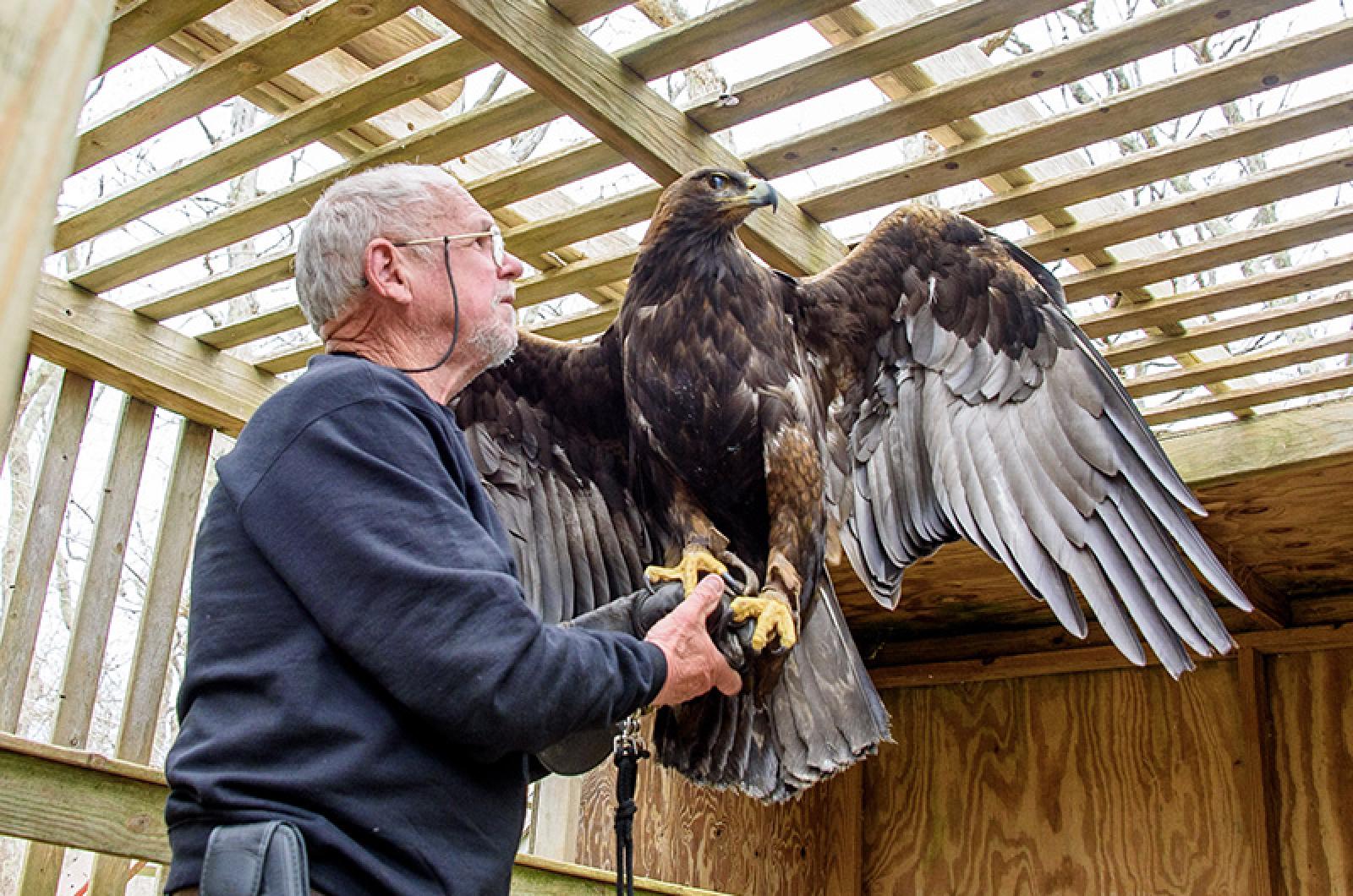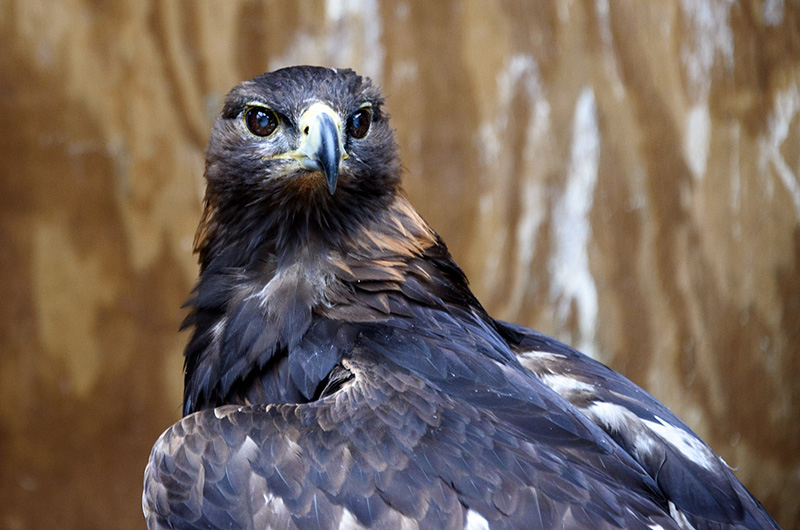To raise a golden eagle, according to Gus Ben David, you need a way of life and time. Mr. Ben David had both when at age 38 he adopted Chameli, a 12-week-old golden eagle hatched at the Roger Williams Park Zoo in Providence, R.I.
But even he didn’t know how much time he would give to the bird of prey he calls his “longtime educational partner.”
On April 20 Chameli turned 40, making her by far the oldest living eagle in North America and maybe the world, according to Mr. Ben David.
Typically an eagle will live to be about 20 years old.
Raising an eagle also requires the necessary government permits, Mr. Ben David is quick to point out. When he adopted Chameli, he was the director of Felix Neck Wildlife Sanctuary and already had decades of experience with birds of prey.
“By the time I was in my early 20s, I had all kinds of federal permits and I had a reputation for rehabilitating birds of prey,” he said in an interview earlier this week, seated in a chair in his outdoor man cave. Unlike most man caves, this one is not a shrine to sports and leisure. Instead, all manner of animal bones and skulls line the walls of the small cabin, along with photographs of reptiles he has raised, including a Burmese Python and a 50-pound snapping turtle named Big Al. The room is heated by a wood stove to near sweat lodge temperatures and features a large picture window that looks out on a clearing anchored by a few shallow ponds where several species of birds and animals congregate, a sight that evokes a watering hole on the Serengeti more than the outskirts of Edgartown.
“For many years the federal government would place eagles with me that needed to be rehabbed to go back to the wild,” he continued. “So then I applied for an educational permit for a golden eagle and one was available.”
Mr. Ben David waited until 12 weeks to bring Chameli home to make sure she wouldn’t imprint on him, creating a surrogate father complex that with a bird of prey with a wing span of over six feet and talons sharp as knives, could get complicated.
“That can get serious when it comes to an eagle who wants to follow you into your room or protect you when someone enters its territory,” he said.
What he wanted instead of a father/daughter relationship was a partnership of mutual respect and trust. For the first few weeks he curled up in a sleeping bag on the ground beside Chameli, ready to offer food whenever she was hungry.
“It’s called the manning process,” he said. “What you’re doing is getting the bird to trust you and to have no fear. And the relationship is through food. You feed it all the time on the fist. Mice, rats, some roadkill.”
“The bird doesn’t love you,” he added, going into teaching mode about the ways of wild animals and the importance of maintaining a neutral distance.
The constant training goes on throughout the life of the bird. Any disruption for even a short a period of time results in a loss of connection and the training needs to start from the beginning. In the past 40 years, Mr. Ben David said he and Chameli have rarely been apart for more than a day, which suits him just fine. The two have traveled all over the Island and all over the country, doing educational workshops at schools, wildlife centers, even parking lots.
“All the children of the Island, in that era of the 70s and 80s, they grew up with an eagle on the Vineyard. You talk with them today and they remember it.”
On the road, Chameli traveled in a wooden box stationed in the back of Mr. Ben David’s truck, which often became an impromptu classroom. “I’d be at a hotel in the parking lot feeding Chameli, and you have to take her out of the box and feed her on the fist, and suddenly you have half the hotel gathering around,” he said. “And it gives you a chance to educate them right there.”
Part of that education, he said, involved talking about the aerodynamics of an eagle, which in a deep dive can reach speeds of up to 100 miles an hour. On the Vineyard, Chameli mostly flew on a creance, a long leash, but she also enjoyed some free-flying time. The key to free-flying, Mr. Ben David said, is to make sure the bird is hungry — hungry enough to want to go out and fly, and hungry enough to want to come back to where the food is waiting for her.
“The first time I put her up in the air it was just spectacular,” he recalled. “She went up maybe 300 feet but she was watching me all the time. She’s circling and then I put my fist up and she comes out of the air like a meteor. Boom, she hit the fist.”
During free-flying moments, Mr. Ben David said he had to be careful to take note of what small animals might be walking about, not knowing they were being eyeballed for lunch.
“When you’re flying a golden eagle, you have to make damn sure somebody doesn’t come walking by with a little Corgi or you’re definitely going to have a mess on your hands,” he said.
But a pair of territorial red tail hawks put an end to most of Chameli’s free-flying, as they would team up like a pair of F18 bombers, Mr. Ben David said, and attack Chameli to protect their nest.
Chameli’s flying days are over now. She is about 99 per cent blind, Mr. Ben David said, as he walked from his office to Chameli’s mew (a bird of prey cage). Upon his approach, Chameli began to move about and make small plaintive cries.
Mr. Ben David put on a thick glove that extended nearly to his elbow, opened the door and walked inside. Chameli cocked her head, then hopped up on his arm and stretched out to nearly her full wing span.
“I’m not sure how much longer we have together,” Mr. Ben David said as the two gazed at each other, nose and beak just a few inches apart.
Then, as if to shake off the moment, he smiled. “Be careful now, people will start to say, old Gus Ben David, he’s getting soft.”









Comments (15)
Comments
Comment policy »